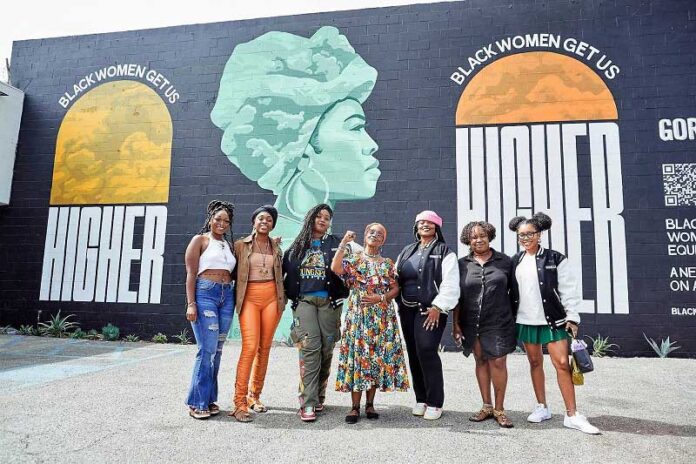
LA’s only dispensary owned by a Black woman is using OOH to work around tricky weed advertising restrictions
If you’ve spent time in LA’s Crenshaw neighborhood recently, you’ve probably seen a mural at the corner of Crenshaw Boulevard and 43rd Street. It shows a woman, head wrapped, next to the words “Black Women Get Us Higher,” almost mimicking a church window’s stained-glass panes.
The mural is part of a launch campaign for Gorilla Rx, a dispensary that opened its doors during the last week of August. Though reflective of the neighborhood’s residents and history, the founder of Gorilla Rx, Kika Keith, doesn’t look like the average dispensary owner: a 2017 survey from Marijuana Business Daily found that 81% of cannabis-business owners and founders were white, while only 4.3% are Black.
According to Keith, Gorilla Rx is LA’s only Black-woman-owned dispensary.
“Everything is set against us to make sure this doesn’t happen, which is why we’re celebrating. We’re almost an anomaly,” Keith’s daughter Kika Howze, who’s leading marketing strategy for the dispensary, told Marketing Brew. “As soon as one of us opens the door, it’ll create hope and opportunity for so many more people.”
The mural was led by marketing agency Decoded, which provides pro bono services to select BIPOC–owned businesses. Aside from creative work, Decoded donated $20,000 to Gorilla Rx for media and other costs.
“Out of home was the one thing that we knew we couldn’t get on our own,” Keith told us. “Now we have metrics. Now I can go back to investors and say, ‘Listen, look at what this did.’”
Gorilla Rx and Decoded had to be strategic with their outdoor placements. As we’ve discussed, advertising pot comes with a whole mess of regulations. For instance, if Gorilla Rx wanted to include any imagery or mentions of the leaf, they would have to make sure the OOH wasn’t anywhere within 1,000 feet of a daycare center, school, or playground. The dispensary would also have to prove that at least 71.6% of people who would see the mural are over the age of 21.
To avoid dealing with restrictions, they opted instead for more abstract visuals and copy instead.
“The words had to stand out; the imagery had to speak for itself without the inclusion of a joint. It compels people to dream the rest, but it’s stifling,” said Howze. The brand added a QR code, which leads to the dispensary’s site, to the mural, and some of its posters. “We have to be cryptic about it because of all the regulations at play.”
Another roadblock
Outside of tricky advertising regulations, Gorilla Rx has come up against another hurdle while promoting its business, Howze told us—struggling to find imagery that actually looks like the customers and community they’re hoping to serve.
“When we began to look at the stock imagery to put into our decks, to be able to present what the dispensary would become or what artwork we could use, there was nothing to pull from,” Howze explained. “We had to put together a photo shoot,” she said, adding that her mother was the inspiration for the woman in the mural. Working with Decoded, the dispensary shot photos that were plastered on some of the brand’s posters and throughout its store. “We had to create this from scratch.”
Outside of its OOH push, the dispensary also recruited about a dozen influencers to post about the launch—already a TikTok featuring the store has gone viral. One of the influencers, producer and actress Lena Waithe, posted herself wearing a Gorilla Rx jacket on Instagram. Keith and Howze hope the image the brand is cultivating will permeate social media and continue to bring in customers, all while avoiding dicey pot marketing regulations.
“If we give people something to talk about, then that word of mouth with social media really carries,” said Howze. “We’re the first, but we’re doing this to make sure we’re not the last.”













